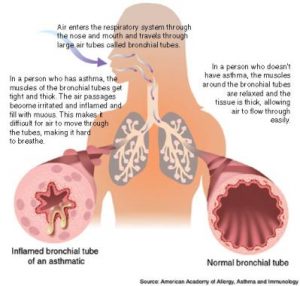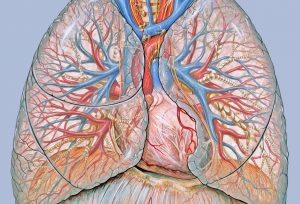Air is breathed in through the nose, mouth or both.
Nose or mouth
The nose is the best route for air to get into the lungs, as it is a better filter than the mouth. The nose decreases the amount of irritants that reach the lungs, whilst also heating and adding moisture to the air.
Mouth breathing is usually needed when exercising or when more air is needed, because the nose is not the most efficient way of getting large amounts of air into the lungs.
Journey down the windpipe
After entering the nose or mouth, air travels down the trachea or “windpipe”. The trachea is the tube lying closest to the neck.
Behind the trachea is the oesophagus or “food tube”. Air moves down the trachea when we inhale and food moves down the oesophagus when we eat.
The path air and food take is controlled by the epiglottis, a gate that prevents food from entering the trachea. Occasionally, food or liquid may enter the trachea, resulting in choking and coughing spasms.
Route into the lungs
The trachea divides into one left and one right breathing tube, termed bronchi. The left bronchus leads to the left lung and the right bronchus leads to the right lung. These breathing tubes continue to divide into smaller tubes called bronchioles.
The end of the trip
The bronchioles end in tiny air sacs called alveoli. Alveoli, which means “bunch of grapes” in Italian, look like clusters of grapes attached to tiny breathing tubes. There are over 300 million alveoli in normal lungs. If the alveoli were opened and laid out flat, they would cover the area of a doubles tennis court. Not all alveoli are in use at one time, so the lung has many to spare in the event of damage from disease, infection or surgery.

